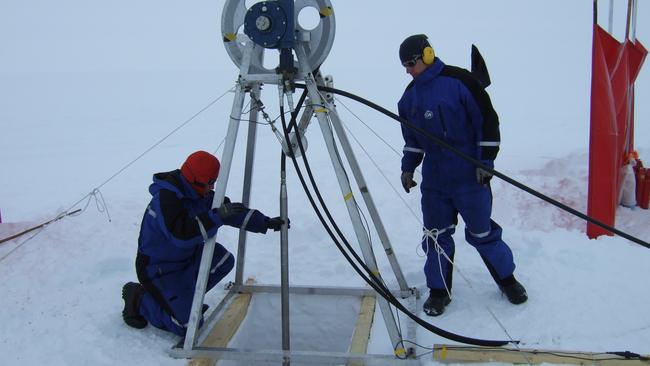Warm water is melting ‘safe’ Fimbulisen Ice Shelf in Antarctica faster than expected, says climate scientist Matthis Auger
Antarctic’s Fimbulisen Ice Shelf, previously thought ‘safe’ from climate change, is melting more rapidly than expected, says a University of Tasmania climate scientist Matthis Auger.

A large body of warm water under an Antarctic ice shelf is melting the ice above it more rapidly than expected, raising the alarm for climate scientists who fear it may contribute to accelerated sea level rise.
University of Tasmania scientist Matthis Auger said water under the Fimbulisen Ice Shelf – in the region of Antarctica south of the Atlantic Ocean – had been seen to be warming in 2016 but it was anticipated that cold water in cavities under the ice would limit melting of the shelf.
“Instead, we found the warming waters led to an increase in the melting of the ice shelf and the loss of glacier mass,” Dr Auger said.
The melting ice shelf has caused scientists to rethink the stability of the East Antarctic region (east of the 0 degrees longitude line) where the Fimbulisen Ice Shelf is located.
“We thought East Antarctica was kept relatively ‘safe’. However, this new study shows that warmer waters have started getting into the ice shelf – causing more melting than we thought,” said Dr Auger, who is based at the ARC Australian Centre for Excellence in Antarctic Science (ACEAS) and the Institute for Marine and Antarctic Studies (IMAS) at the University of Tasmania.

Accelerated melting of ice shelves due to warmer ocean water is already well documented in West Antarctica, but now climate scientists fear it is more widespread.
While the melting of a floating ice shelf does not, in itself, increase sea levels, the weakening of an ice shelf allows the glacier behind it to accelerate its slide towards the water, adding to sea level rise.
The melting of the Fimbulisen Ice Shelf is detailed in a new study published in Nature Geocience of which Dr Auger is a co-author.
The study found that the warming of waters under East Antarctic ice shelves is caused by the reduction in coastal sea ice cover and a strengthening of subpolar winds which are bringing warmer water closer to the coast.
Of further worry to scientists is the fact that Antarctic sea ice was at a record low for the second year running in 2023 and climate projections show a continuing acceleration of westerly winds.
“Further melting of the East Antarctic ice shelves is a concern. This region of Antarctica is traditionally considered ‘cold’, unlike West Antarctica – where most of Antarctica’s mass loss occurs today,” Dr Auger said.
“We are only just beginning to understand the critical significance of climate related changes in this part of the world – and it is crucial this research continues, so we can better predict and prepare for future ice sheet stability and global sea level rise.”




To join the conversation, please log in. Don't have an account? Register
Join the conversation, you are commenting as Logout